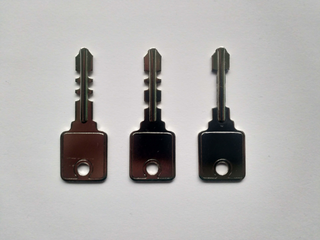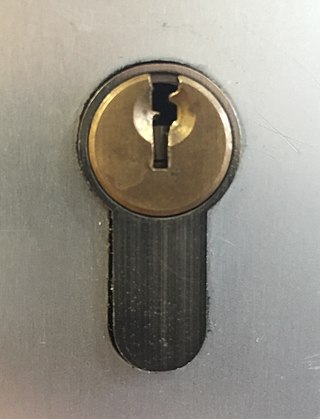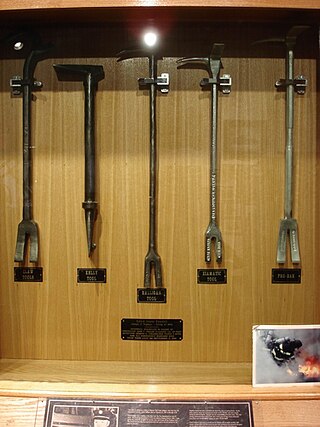
Lock picking is the practice of unlocking a lock by manipulating the components of the lock device without the original key.

A warded lock is a type of lock that uses a set of obstructions, or wards, to prevent the lock from opening unless the correct key is inserted. The correct key has notches or slots corresponding to the obstructions in the lock, allowing it to rotate freely inside the lock.

The pin tumbler lock is a lock mechanism that uses pins of varying lengths to prevent the lock from opening without the correct key. Pin tumblers are most commonly employed in cylinder locks, but may also be found in tubular pin tumbler locks.

A disc tumbler or disc detainer lock is a lock composed of slotted rotating detainer discs. The lock was invented by Finnish founder of Abloy, Emil Henriksson (1886–1959) in 1907 and first manufactured under the Abloy brand in 1918.

A lock is a mechanical or electronic fastening device that is released by a physical object, by supplying secret information, by a combination thereof, or it may only be able to be opened from one side, such as a door chain.

A Halligan bar is a forcible entry tool used by firefighters.

A bank vault is a secure space where money, valuables, records, and documents are stored. It is intended to protect their contents from theft, unauthorized use, fire, natural disasters, and other threats, much like a safe. Unlike safes, vaults are an integral part of the building within which they are built, using armored walls and a tightly fashioned door closed with a complex lock.

A door handle or doorknob is a handle used to open or close a door. Door handles can be found on all types of doors including exterior doors of residential and commercial buildings, internal doors, cupboard doors and vehicle doors. There are many designs of door handle, depending on the appropriate use. A large number of handles, particularly for commercial and residential doors, incorporate latching or locking mechanisms or are manufactured to fit to standardised door locking or latching mechanisms.
This is a glossary of firefighting equipment.

The TNT Tool is a multi-purpose tool used by firefighters, emergency personnel, and law enforcement officers to gain forcible entry to buildings, automobiles, etc. during emergency situations. It is a combination axe, sledgehammer, pry tool, ram, and D-handle pull tool. It is also carried by off-roaders and those traveling in remote areas.

A latch or catch is a type of mechanical fastener that joins two objects or surfaces while allowing for their regular separation. A latch typically engages another piece of hardware on the other mounting surface. Depending upon the type and design of the latch, this engaged bit of hardware may be known as a keeper or strike.

A wafer tumbler lock is a type of lock that uses a set of flat wafers to prevent the lock from opening unless the correct key is inserted. This type of lock is similar to the pin tumbler lock and works on a similar principle. However, unlike the pin tumbler lock, where each pin consists of two or more pieces, each wafer in the lock is a single piece. The wafer tumbler lock is often incorrectly referred to as a disc tumbler lock, which uses an entirely different mechanism.
The pig is a specialty firefighting tool used mainly for roof ventilation, forcible entry and wall breaching. Invented by a member of the Austin Fire Department, the tool combines the butt-end of a flat head axe on one side and a pick on the other. The pig can be married with a Halligan to create a forcible entry system as an alternative to the classic axe and Halligan combination.

Door breaching is a process used by military, police, or emergency services to force open closed or locked doors. A wide range of methods are available depending on the door's opening direction, construction materials, etc., and one or more of these methods may be used in any given situation. In the United States, residential doors typically open inward while commercial building doors usually open outward. Some breaching methods require specialized equipment and can be categorized as one of the following: mechanical breaching, ballistic breaching, hydraulic breaching, explosive breaching, or thermal breaching.

The Kelly tool is a tool used in fire and rescue service for forcible entry and other prying and striking tasks. The predecessor of the Halligan bar, it has largely been superseded by the latter, but still sees some use.

An axe is an implement that has been used for millennia to shape, split and cut wood, to harvest timber, as a weapon, and as a ceremonial or heraldic symbol. The axe has many forms and specialised uses but generally consists of an axe head with a handle, or helve.

An electromagnetic lock, magnetic lock, or maglock is a locking device that consists of an electromagnet and an armature plate. There are two main types of electric locking devices. Locking devices can be either "fail safe" or "fail secure". A fail-secure locking device remains locked when power is lost. Fail-safe locking devices are unlocked when de-energized. Direct pull electromagnetic locks are inherently fail-safe. Typically the electromagnet portion of the lock is attached to the door frame and a mating armature plate is attached to the door. The two components are in contact when the door is closed. When the electromagnet is energized, a current passing through the electromagnet creates a magnetic flux that causes the armature plate to attract to the electromagnet, creating a locking action. Because the mating area of the electromagnet and armature is relatively large, the force created by the magnetic flux is strong enough to keep the door locked even under stress.
An officer’s tool is a forcible entry device used by firefighters and other first responders. Officer’s tools are designed to completely remove cylindrical locks from doors without causing major structural damage, allowing for direct access to the internal locking mechanism.
The trash hook, also known as a "trash tool" or a "forcible entry hook," is a specialized tool used by firefighters to gain access to buildings or other structures in emergency situations. It is a long, curved blade with a sharp, pointed tip, and it is typically made of metal.
This is a glossary of locksmithing terms.















